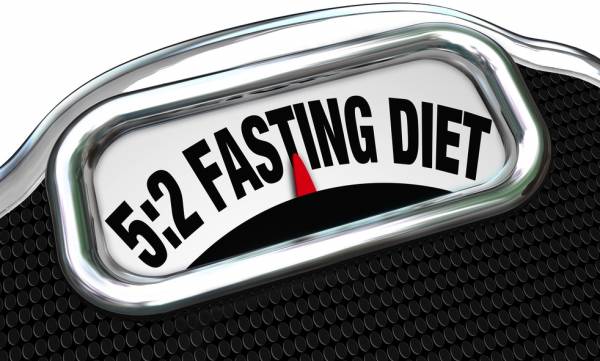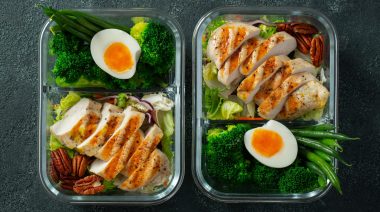At any given time, a certain diet makes its way through the general population. As the low-carb group is losing steam, enter the 5:2 Fast Diet. The basic premise is to fast two days out of the week.
Research is beginning to show some physiological benefits to skipping certain meals, the practice of which is often called intermittent fasting, or IF. I think IF has tremendous value for people who do well with black-and-white rules, like not eating after a certain amount of time in the afternoon. But let’s take a look at what the 5:2 Fast Diet really is and if it may be a feasible option for someone looking to lose weight.
How Does 5:2 Work?
The 5:2 Fast Diet protocol is to eat normally five days out of the week and fast for two non-consecutive days. A person would begin by figuring out how many calories they should eat five days out of the week. From there, you pick two days where you will only eat a quarter of your normal day’s calories. This comes out to roughly 500 calories for a woman and 600 for men. (It’s good to be a guy.)
“For most people, the approach should be to start with small but powerful changes. Then once they have a solid foundation, short-term protocols can be used to shed the last five to ten pounds or get lean for a vacation.”
The tricky part about this diet is that “normal eating” isn’t quite what it sounds. Counting calories is a tall order for a person new to dieting. To make it more complicated, even the fasting days aren’t really what they seem. They recommend splitting up your two fasting meals, a few hundred calories each, by twelve hours. So on a fasting day, you would have a tiny breakfast, and not eat until twelve hours later when you get to have a small evening snack.

A Short-Term Protocol
The challenge with any diet is handling all the required lifestyle changes at once. In addition to counting calories and navigating fasting, many people also start an exercise routine to go with the 5:2 Fast Diet. Incorporating three new things into an already busy lifestyle is usually an impossible task. That is part of what makes this diet a fad – they are selling an advanced protocol to regular consumers. Of course, this regimen will get great fat loss results – everything works, if you can do it.
In addition, the book states that counting calories or following their meal plan isn’t essential for the long term. But not counting calories and simply trying to be reasonable probably won’t work. People who attempt this protocol usually are far removed from “reasonable” in the first place. Allowing this sort of discretion takes away the benefit of the black-and-white rules and adds in opportunities to stretch the boundaries until eventually you are on the seven-day eat-everything diet (my personal favorite).
“I would advise approaching the diet in steps. First, go into it with a mindset that you can’t fail. Sure, you may not be able to stick to any or all of it. But learn from it anyway.”
As in most fad diets, the sequence is backward. Yes, some people may do the diet and keep it off for years, but in reality, they did a difficult starting protocol and worked backward to a more reasonable habit system. Some people are wired this way. But for most people, the approach should be to start with small but powerful changes. Then once they have a solid foundation, short-term protocols can be used to shed the last five to ten pounds or get lean for a vacation.

How to Screen Your Clients
I use a basic screen with clients to quickly see if they can handle a protocol like the Fast Diet. If they say yes to any of the following, it’s a no go.
- Do you eat less than two cups of vegetables daily? (No, you can’t count corn and potatoes.)
- In the last ten years, have you cycled your weight more than fifteen pounds by “successfully” dieting and putting it back on more than three times? (Weight dependent athletes are obviously excluded here.)
- Do you prepare less than half your meals at home?
Most people will agree with that basic screen. For the people who don’t pass, adding in a vegetable a week or drinking more water may be a start. However, I’ve worked with enough clients to know one thing: if you’re asking me about it, then you’re going to do the diet no matter what I say.
The Best Approach
I would advise approaching the diet in steps. First, go into it with a mindset that you can’t fail. Sure, you may not be able to stick to any or all of it. But learn from it anyway. If the black-and-white approach of fasting simplifies things for you, take note. A lighter form of intermittent fasting may be part of the solution that works for you long term.
I always listen for dieting history from new clients. If Atkins worked for them in the past but was too strict, I’ll keep that in mind. Perhaps a solution might be a reasonable approach of slightly less carbohydrate intake and higher fat. Use past experiments of fad dieting to help you gain insight into what works. If you can learn something from it, it isn’t a failure at all.
“My suggested fix if you were to do the diet is to look in the mirror and agree that success is not built around the physical outcome. Once you have that mindset, begin by journaling your food.”
The next few steps are to break down the diet protocol itself. Take a few weeks and journal your food. For some people this action alone can make a huge difference. Once you have some data, use one of the calorie calculators available on the website. Where do you stack up to the recommended levels (which are usually 2,000-2,500 calories)?
If you are well above this mark, the fasting days need to be adjusted. The creators of the diet want the fasting days to be a quarter of normal intake. They say it comes out to 500-600 calories, but if your normal days are higher than what they recommend, your fasting day requirements should also be higher. So if you are consuming 3,000 calories, the fast days should be close to 750 calories. Spend a few weeks to a few months working on getting your calories to the recommended levels, and adjust fasting days accordingly.

Keep It Simple
So, this takes us back to the original approach to this diet – figure out calories, try to stay within those numbers for five days a week, and stay under 500-600 calories on the other days. Do that all at once. Starting now.
My suggested fix if you were to do the diet is to look in the mirror and agree that success is not built around the physical outcome. Once you have that mindset, begin by journaling your food. Compare this to what you should be consuming, and over time take steps to get there. Don’t try to do everything at once.
People with a lot of weight to lose will see results from each step of this process. For beginners, adjustment you take may take some time for you to really adapt to. For those who are a bit more advanced, these steps may take only days or weeks. The funny thing is, if you are already advanced, chances are you didn’t need a different protocol than what you are already doing anyway.
You Might Also Enjoy:
- Is Intermittent Fasting Right for You?
- How to Avoid the Fad Diet Cycle (and Keep the Weight Off)
- How Restricting Calories and Nutrients Affects Your Health
- What’s New on Breaking Muscle Today
References:
1. Mosley, Dr. Michael, and Mimi Spencer. The Fast Diet. New York: Atria Books, 2013
2. The 5:2 Fast Diet. Accessed January 25, 2015.
Photos 2-4 courtesy of Shutterstock.






